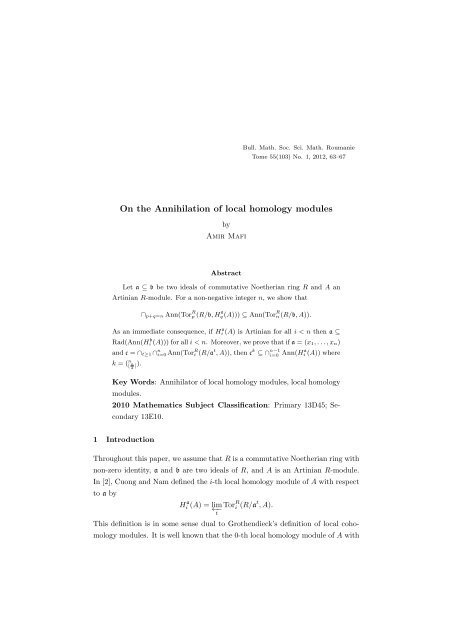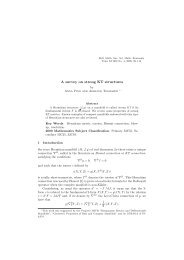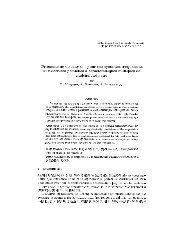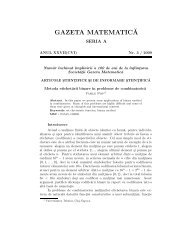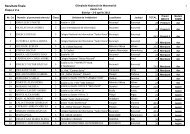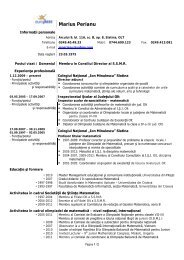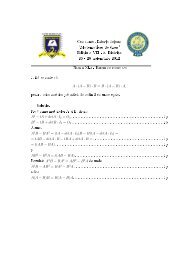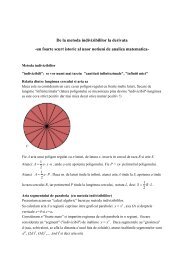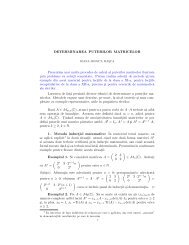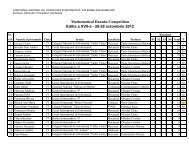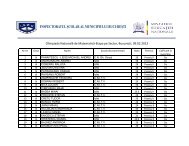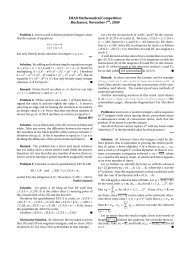On the Annihilation of local homology modules - SSMR
On the Annihilation of local homology modules - SSMR
On the Annihilation of local homology modules - SSMR
Create successful ePaper yourself
Turn your PDF publications into a flip-book with our unique Google optimized e-Paper software.
Bull. Math. Soc. Sci. Math. RoumanieTome 55(103) No. 1, 2012, 63–67<strong>On</strong> <strong>the</strong> <strong>Annihilation</strong> <strong>of</strong> <strong>local</strong> <strong>homology</strong> <strong>modules</strong>byAmir MafiAbstractLet a ⊆ b be two ideals <strong>of</strong> commutative Noe<strong>the</strong>rian ring R and A anArtinian R-module. For a non-negative integer n, we show that⊓ p+q=n Ann(Tor R p (R/b, H a q (A))) ⊆ Ann(Tor R n (R/b, A)).As an immediate consequence, if H a i (A) is Artinian for all i < n <strong>the</strong>n a ⊆Rad(Ann(H b i (A))) for all i < n. Moreover, we prove that if a = (x 1, . . . , x n)and c = ∩ t≥1 ∩ n i=0 Ann(Tor R i (R/a t , A)), <strong>the</strong>n c k ⊆ ∩ n−1i=0 Ann(Ha i (A)) wherek = ( n [ n 2 ] ).Key Words: Annihilator <strong>of</strong> <strong>local</strong> <strong>homology</strong> <strong>modules</strong>, <strong>local</strong> <strong>homology</strong><strong>modules</strong>.2010 Ma<strong>the</strong>matics Subject Classification: Primary 13D45; Secondary13E10.1 IntroductionThroughout this paper, we assume that R is a commutative Noe<strong>the</strong>rian ring withnon-zero identity, a and b are two ideals <strong>of</strong> R, and A is an Artinian R-module.In [2], Cuong and Nam defined <strong>the</strong> i-th <strong>local</strong> <strong>homology</strong> module <strong>of</strong> A with respectto a byHi a (A) = lim Tor R ←−t i (R/a t , A).This definition is in some sense dual to Gro<strong>the</strong>ndieck’s definition <strong>of</strong> <strong>local</strong> co<strong>homology</strong><strong>modules</strong>. It is well known that <strong>the</strong> 0-th <strong>local</strong> <strong>homology</strong> module <strong>of</strong> A with
64 Amir Mafirespect to a, H a 0 (A), is always Artinian, simply because <strong>the</strong>re exists an integer tsuch that H a 0 (A) ∼ = A/a t A. But what about <strong>the</strong> following question: what is <strong>the</strong>largest integer n such that all <strong>the</strong> <strong>modules</strong> Hi a (A) are Artinian for all i < n? Thisquestion is dual to <strong>the</strong> question <strong>of</strong> which ideals annihilate <strong>the</strong> <strong>local</strong> co<strong>homology</strong><strong>modules</strong>, and <strong>the</strong> classical <strong>the</strong>orem on <strong>local</strong> co<strong>homology</strong> <strong>modules</strong> is Faltings’ AnnihilatorTheorem [4]. There are not many results concerning <strong>the</strong> finiteness <strong>of</strong><strong>local</strong> <strong>homology</strong> <strong>modules</strong>. In this regard, see [3], [6] and [7].In this paper, for each ideals a and b <strong>of</strong> R with a ⊆ b, we show a relationshipbetween <strong>the</strong> annihilators <strong>of</strong> <strong>the</strong> <strong>modules</strong> Tor R i (R/b, A) and Tor R i (R/b, H a j (A)).This provides a new characterization <strong>of</strong> <strong>the</strong> concept <strong>of</strong> A-coregular sequence <strong>of</strong> anarbitrary ideal <strong>of</strong> R. Also, we prove that if n is a non-negative integer such thatHi a(A) is Artinian for all i < n, <strong>the</strong>n a ⊆ Rad(Ann(Hb i (A))) for all i < n. Moreover,we show that if a = (x 1 , . . . , x n ) and c = ∩ t≥1 ∩ n i=0 Ann(TorR i (R/a t , A)),<strong>the</strong>n c k ⊆ ∩ n−1i=0 Ann(Ha i (A)) where k = (n [ n 2 ]).2 The resultsThe following <strong>the</strong>orem is dual <strong>of</strong> [5, Theorem 2.2].Theorem 2.1. Let a ⊆ b be two ideals <strong>of</strong> R, and n a non-negative integer. Then⊓ p+q=n Ann(Tor R p (R/b, H a q (A))) ⊆ Ann(Tor R n (R/b, A)).Pro<strong>of</strong>: Let us consider functors F (−) = R/b ⊗ R − and G(−) = H a 0 (−). Thefunctor F is obviously right exact and a projective module P implies H a 0 (P ) isflat by [1, 1.4.7] or [11, 2.4]. Combining [9, Theorem 11.39] with [11, Theorem1.1] yields a Gro<strong>the</strong>ndieck spectral sequenceE 2 p,q := Tor R p (R/b, H a q (A)) =⇒pTor R p+q(R/b, A).Thus, for each n ≥ 0, <strong>the</strong>re is a finite filtration <strong>of</strong> <strong>the</strong> module H n = Tor R n (R/a, A)0 = φ −1 H n ⊆ φ 0 H n ⊆ . . . ⊆ φ n−1 H n ⊆ φ n H n = H nsuch that E ∞ i,n−i ∼ = φ i H n /φ i−1 H n for all 0 ≤ i ≤ n (see [9, §11]). Since E ∞ i,n−iis a subquotient <strong>of</strong> E 2 i,n−i for all 0 ≤ i ≤ n, it implies that φi H n /φ i−1 H n isannihilated by Ann(Tor R i (R/b, Hn−i a (A))) for all 0 ≤ i ≤ n. Thus, we get that⊓ p+q=n Ann(Tor q p(R/b, Hq a (A)) annihilates <strong>the</strong> <strong>homology</strong> module Tor R n (R/b, A).This completes <strong>the</strong> pro<strong>of</strong>.
<strong>On</strong> <strong>the</strong> <strong>Annihilation</strong> <strong>of</strong> <strong>local</strong> <strong>homology</strong> <strong>modules</strong> 65A sequence <strong>of</strong> elements x 1 , . . . , x n in R is said to be an A-coregular sequence(see [8, Definition 3.1]) if 0 : A (x 1 , . . . , x n ) ≠ 0 andx0 : A (x 1 , . . . , x i−1 ) −→i0 :A (x 1 , . . . , x i−1 ) is surjective for i = 1, 2, . . . , n. Wedenote by width(a, A) <strong>the</strong> supremum <strong>of</strong> <strong>the</strong> lengths <strong>of</strong> all maximal A-coregularsequences in <strong>the</strong> ideal a.Corollary 2.2. Let a be an ideal <strong>of</strong> R such that 0 : A a ≠ 0. Then width(a, A) =inf{n : Tor R i (R/a, Hj a (A)) ≠ 0 for some non-negative integers i, j with i+j = n}.Pro<strong>of</strong>: We denote by B <strong>the</strong> set in <strong>the</strong> above equality. In view <strong>of</strong> [3, Theorem4.11] it follows that width(a, A) ≤ inf B. <strong>On</strong> <strong>the</strong> o<strong>the</strong>r hand, by Theorem 2.1 and[8, Theorem 3.9] we have inf B ≤ width(a, A). This finishes <strong>the</strong> pro<strong>of</strong>.Corollary 2.3. Let a ⊆ b be two ideals <strong>of</strong> R. Then, for each non-negative integern, ⊓ n i=0 Ann(Ha i (A)) ⊆ ∩ t≥1 ∩ n i=0 Ann(TorR i (R/b t , A)).Pro<strong>of</strong>: Let t be a positive integer. Then a t ⊆ b t . Hence, for each non-negativeinteger m, it follows from Theorem 2.1 and [2, Remark 2.1(ii)] that⊓ i+j=m Ann Tor R i (R/b t , Hj a(A)) ⊆ Ann(TorR m(R/b t , A)). Since <strong>the</strong> Tor functorsare linear, <strong>the</strong> result now follows.Theorem 2.4. Let a ⊆ b be two ideals <strong>of</strong> R, and n a non-negative integer suchthat Hi a(A) is Artinian for all i < n. Then a ⊆ Rad(Ann(Hb i (A))) for all i < n.Pro<strong>of</strong>: By [2, Proposition 4.7], <strong>the</strong>re exists a positive integer m such thata m Hi a(A) = 0 for all i < n. Put l := mn. Then al ⊆ ⊓ n−1i=0 Ann(Ha i (A)).Thus, by Corollary 2.3 a l ⊆ ∩ n−1i=0 Ann(TorR i (R/b t , A)) for all t ∈ N. Thereforea l Hi b(A) = 0 for all i < n and so a ⊆ Rad(Ann(Hb i (A))) for all i < n, as required.We prove <strong>the</strong> following <strong>the</strong>orem by similar techniques that used in [10, Theorem3].Theorem 2.5. Let n be a non-negative integer such that a = (x 1 , . . . , x n ). Ifc = ∩ t≥1 ∩ n i=0 Ann(TorR i (R/a t , A)), <strong>the</strong>n c k ⊆ ∩ n−1i=0 Ann(Ha i (A)) where k = (n [ n 2 ]).
66 Amir MafiPro<strong>of</strong>: First we show, for k ≤ n, that (c) (k i ) H i (x t 1, . . . , x t k; A) = 0, for 0 ≤ i < kand t ≥ 1. To this end we make an induction on k. If k = 1 and i = 0, <strong>the</strong>nH 0 (x t 1; A) ∼ = A/x t 1A is annihilated by c. Assume k ≥ 2. We show <strong>the</strong> statementby induction on i. For i = 0 we have <strong>the</strong> exact sequenceA/x t 1A −→ H 0 (x t 1, . . . , x t k; A) −→ 0and <strong>the</strong> assertion is true. For i ≥ 1 <strong>the</strong>re is a short exact sequence0 −→ H i (x t 1, . . . , x t k−1; A)/x t kH i (x t 1, . . . , x t k−1; A) −→ H i (x 1 , . . . , x t k; A)−→ (0 : Hi−1(x t 1 ,...,xt k−1 ;A) x t k) −→ 0,t ≥ 1. If i < k − 1, <strong>the</strong> induction hypo<strong>the</strong>sis yields <strong>the</strong> statement. In <strong>the</strong> casei = k − 1 we getH i (x t 1, . . . , x t k−1; A)/x t kH i (x t 1, . . . , x t k−1; A) ∼ = R/(x t 1, . . . , x t k)⊗(0 : A (x t 1, . . . , x t k−1)).Hence <strong>the</strong> short exact sequence proves <strong>the</strong> statement on <strong>the</strong> annihilation.In particular, we have (c) (k i ) H i (x t 1, . . . , x t k; A) = 0 (0 ≤ i < n, t ≥ 1).By [2, Theorem 3.6], we have Hi a (A) = limH ←− i (x t 1, . . . , x t n; A). Note thatt(c) (n i ) limH i (x t ←−t 1, . . . , x t n; A) ⊆ lim(c) (n i ) H i (x t ←−t 1, . . . , x t n; A) = 0. Therefore it follows(c) (n i ) Hi a (A) = 0, which proves <strong>the</strong> statement.Acknowledgement . The author is deeply grateful to <strong>the</strong> referee for carefullyreading <strong>of</strong> <strong>the</strong> original manuscript and <strong>the</strong> valuable suggestions. The author alsowould like to thank Dr. Hero Saremi for many helpful discussions during <strong>the</strong>preparation <strong>of</strong> this paper.References[1] J. Bartijn, Flatness, completions, regular sequences, un ménage à trois.Thesis, Utrecht, (1985).[2] N.T. Cuong and T. T. Nam, The I-adic completion and <strong>local</strong> <strong>homology</strong>for Artinian <strong>modules</strong>, Math. Proc. Camb. Phil. Soc., 131(2001), 61-72.[3] N.T. Cuong and T.T. Nam, A <strong>local</strong> <strong>homology</strong> <strong>the</strong>ory for lineary compact<strong>modules</strong>, J. Algebra, 319 (2008), 4712-4737.
<strong>On</strong> <strong>the</strong> <strong>Annihilation</strong> <strong>of</strong> <strong>local</strong> <strong>homology</strong> <strong>modules</strong> 67[4] G. Faltings, Uber die annulatoren lokaler kohomologiegruppen, Arch.Math., 30(5)(1978), 473-476.[5] K. Khashyarmanesh, <strong>On</strong> <strong>the</strong> annihilators <strong>of</strong> <strong>local</strong> co<strong>homology</strong> <strong>modules</strong>,Comm. Algebra, 37(2009), 1787-1792.[6] A. Mafi and H. Saremi, Coassociated primes <strong>of</strong> <strong>local</strong> <strong>homology</strong> and <strong>local</strong>co<strong>homology</strong> <strong>modules</strong>, Rocky Mountain J. Math., 41(5)(2011), 1631-1638.[7] A. Mafi and H. Saremi, <strong>On</strong> <strong>the</strong> finiteness <strong>of</strong> <strong>local</strong> <strong>homology</strong> <strong>modules</strong>,Rend. Semin. Mat. Univ. Politec. Torino, 67(2009), 115-122.[8] A. Ooishi, Matlis duality and <strong>the</strong> width <strong>of</strong> a module, Hiroshima Math. J.,6 (1976), 573-587.[9] J. Rotman, Introduction to homological algebra, (Academic Press, 1979).[10] P. Schenzel, Cohomological annihilators, Math. Proc. Camb. Phil. Soc.,91(1982), 345-350.[11] A. M. Simon, Some homological properties <strong>of</strong> complete <strong>modules</strong>, Math.Proc. Camb. Phil. Soc., 108(1990), 231-246.Received: 25.05.2010,Revised: 28.12.2010,Accepted: 10.12.2011.Department <strong>of</strong> Ma<strong>the</strong>matics,University <strong>of</strong> Kurdistan,Pasdaran St., P.O. Box: 416,Sanandaj, IranandSchool <strong>of</strong> Ma<strong>the</strong>matics,Institute for Researchin Fundamental Science (IPM),P.O. Box 19395-5746,Tehran, Iran.E-mail: a mafi@ipm.ir


